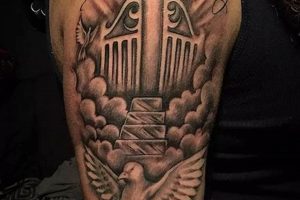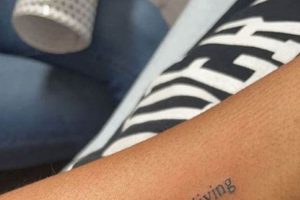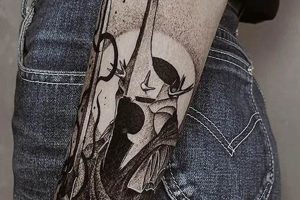Lower back tattoos, often placed just above the buttocks, gained popularity in the late 1990s and early 2000s. Common designs included butterflies, flowers, tribal art, and lower back-encircling bands. These placements offered a canvas for self-expression in a relatively discreet area, easily concealed or displayed depending on attire.
The placement offered a unique blend of visibility and concealability, allowing individuals to choose when and where to share their body art. This era saw a surge in body art’s acceptance in mainstream culture, and this particular placement became a prominent trend, particularly among young women. While the term associated with this placement carries negative connotations and is considered derogatory, understanding its historical context helps to analyze its cultural significance.
Exploring design options requires careful consideration of placement, size, and artistic style. Factors such as pain tolerance, body shape, and long-term aesthetic goals should influence decision-making. Popular contemporary styles include minimalist designs, fine line work, and watercolor effects. Understanding the healing process and aftercare procedures is crucial for maintaining the vibrancy and longevity of the artwork.
1. Placement
Placement is paramount when considering lower back tattoos. It directly impacts the design’s visual appeal and how it interacts with the body’s natural contours. Careful consideration of placement ensures the artwork complements the individual’s form and enhances its aesthetic impact.
- Centralized:
A centralized placement, directly above the spine, emphasizes symmetry and balance. This location suits designs that are vertically oriented or radiate outwards, such as mandalas or geometric patterns. It creates a focal point and can accentuate the lower back’s curve.
- Offset:
An offset placement, positioned slightly to one side, offers an asymmetrical aesthetic. This can create a sense of movement and visual interest, particularly with designs that incorporate flowing lines or organic shapes like floral patterns or vines. This placement can also complement existing tattoos or body piercings.
- Bilateral:
Bilateral placement involves two mirroring designs, one on each side of the lower back. This approach emphasizes symmetry and creates a balanced visual. Common choices for bilateral placement include wings, floral motifs, or tribal designs. Its crucial to ensure both sides maintain visual harmony.
- Encircling:
Encircling designs wrap around the lower back, following the natural curve of the hips. This placement can create a sense of fluidity and continuity. Common examples include chains, floral garlands, or tribal bands. The design should complement the body’s contours and maintain visual coherence as it wraps around.
Ultimately, the chosen placement significantly influences the overall composition and impact of a lower back tattoo. Careful consideration of these options, in conjunction with the chosen design, ensures a harmonious and aesthetically pleasing result that complements the individual’s unique form.
2. Size
Size plays a crucial role in the overall impact and aesthetic of lower back tattoos. The chosen size should complement both the design itself and the individual’s body shape. A small, intricate design might get lost on a larger frame, while an overly large design could appear overwhelming on a smaller frame. Proportions are key to ensuring the tattoo harmonizes with the body’s natural contours.
Consider a delicate, single-flower design. Executed in a small size, it offers a subtle, understated aesthetic. However, scaling up the same design significantly changes its presence, potentially creating a bold statement piece. Conversely, a large, intricate tribal design might overwhelm a smaller area, losing detail and impact. Scaling down such a design allows for better clarity and visual balance. Therefore, understanding the interplay between size, design complexity, and body proportions is essential for successful execution.
Choosing the appropriate size requires careful consideration of several factors. The design’s level of detail dictates how much space is required for clear visual representation. Intricate designs necessitate larger sizes to avoid a cluttered or muddled appearance. Similarly, the individual’s personal preference plays a significant role. Some prefer smaller, more discreet tattoos, while others opt for larger, more prominent artwork. Ultimately, achieving a balanced and aesthetically pleasing result depends on the harmonious relationship between size, design, and the individual’s physique.
3. Style
Style significantly influences the overall aesthetic and impact of lower back tattoos. The chosen style should reflect personal preferences and complement the design’s subject matter. Understanding different stylistic approaches allows for informed decisions that align with individual tastes and desired outcomes.
- Traditional:
Traditional tattoo styles, characterized by bold lines, vibrant colors, and iconic imagery, offer a timeless appeal. Common motifs include anchors, roses, and swallows. Applied to lower back tattoos, these styles create a striking visual, often conveying symbolic meanings associated with these classic images.
- Realism:
Realism focuses on replicating images with lifelike accuracy. Portraits, animals, and natural scenes are common subjects. In the context of lower back tattoos, realism can create stunning, detailed artwork. However, this style demands a skilled artist capable of capturing intricate details and nuances.
- Watercolor:
Watercolor tattoos mimic the soft, diffused look of watercolor paintings. Characterized by flowing colors and dreamlike aesthetics, they offer a unique and artistic approach. This style lends itself well to floral designs, abstract patterns, and ethereal imagery, creating a visually captivating and expressive tattoo.
- Minimalist:
Minimalist tattoos emphasize simplicity and clean lines. Often using black ink and geometric shapes, they create a subtle yet impactful statement. This style works well for smaller lower back tattoos, offering a discreet and elegant aesthetic. Common minimalist designs include outlines of objects, simple geometric patterns, and small, symbolic imagery.
Selecting an appropriate style is crucial for achieving a desired aesthetic outcome. Factors such as design complexity, color palettes, and personal preferences influence style choices. A well-chosen style harmonizes with the design’s subject matter, creating a cohesive and visually appealing piece of body art that reflects individual expression.
4. Subject Matter
Subject matter constitutes a crucial element in lower back tattoo designs. The chosen imagery carries personal significance, reflecting individual narratives, beliefs, or aesthetic preferences. Careful consideration of subject matter ensures the tattoo resonates with the wearer and conveys intended meanings effectively.
- Nature-Inspired:
Nature-inspired imagery, including flowers, animals, and celestial bodies, represents a popular choice. Floral motifs, such as roses or cherry blossoms, can symbolize beauty, growth, or remembrance. Animal depictions, like butterflies or birds, often represent freedom, transformation, or spiritual connection. Celestial themes, such as stars or moons, can evoke a sense of wonder, mystery, and connection to the universe. These natural elements offer a diverse range of symbolic interpretations and aesthetic possibilities.
- Cultural Symbols:
Cultural symbols drawn from various traditions and mythologies provide rich sources of inspiration. Mandala designs, originating from Buddhist and Hindu traditions, represent wholeness, harmony, and the universe. Celtic knots symbolize interconnectedness, eternity, and spiritual journeys. Tribal patterns, often rooted in indigenous cultures, can represent heritage, strength, and connection to ancestral roots. Incorporating cultural symbols allows individuals to express their heritage, beliefs, and personal connections to specific traditions.
- Abstract Designs:
Abstract designs offer a non-representational approach, focusing on shapes, lines, and patterns rather than literal depictions. Geometric patterns can represent order, structure, and balance. Fluid, swirling lines can evoke a sense of movement, energy, and emotion. Abstract designs allow for personal interpretation and offer a unique aesthetic that resonates with individual sensibilities. This approach prioritizes visual impact and artistic expression over literal representation.
- Script and Text:
Incorporating script and text allows for direct expression of personal values, beliefs, or mantras. Quotes from literature, poetry, or song lyrics can convey meaningful messages or commemorate significant experiences. Names or dates can serve as personal reminders or tributes to loved ones. Choosing meaningful script and fonts enhances the aesthetic and symbolic value of the tattoo, adding a layer of personal significance.
Ultimately, the selected subject matter imbues the lower back tattoo with personal meaning and significance. Whether drawing inspiration from nature, culture, abstract concepts, or written language, the chosen imagery reflects individual narratives and contributes to a deeper connection with the artwork. The interplay between subject matter, placement, and style creates a cohesive and meaningful piece of self-expression.
5. Personal Meaning
Personal meaning forms the core of impactful lower back tattoos. While societal perceptions and trends may influence stylistic choices, the true significance lies in the individual’s narrative embedded within the artwork. This personal connection transforms the tattoo from mere decoration into a powerful symbol of self-expression, reflecting experiences, values, and aspirations. A seemingly simple design can hold deep personal meaning, invisible to outside observers but profoundly resonant for the wearer.
Consider a woman choosing a hummingbird tattoo. For her, it might symbolize resilience, inspired by observing the tiny bird’s tenacity during a challenging period in her life. Alternatively, a seemingly generic floral design could represent a connection to a loved one, perhaps mirroring flowers from a cherished garden. These personal narratives infuse the tattoo with emotional depth, creating a lasting connection beyond its aesthetic qualities. The physical placement on the lower back can further amplify this personal meaning, representing sensuality, femininity, or a connection to the body’s core strength.
Understanding the centrality of personal meaning challenges superficial interpretations based solely on societal trends or perceived connotations. It encourages a shift towards appreciating the individual stories etched onto the skin. While aesthetic considerations remain important, acknowledging the personal significance elevates the tattoo into a powerful form of self-expression and storytelling. This recognition fosters a deeper appreciation for the art form and its capacity to reflect the multifaceted nature of human experience.
Tips for Lower Back Tattoo Designs
Careful planning ensures a successful and meaningful lower back tattoo. These tips offer guidance for navigating the design process, from concept to execution.
Tip 1: Research Thoroughly: Explore various artists, styles, and designs before committing. Review portfolios and seek recommendations to find an artist specializing in the desired style. Thorough research ensures artistic compatibility and minimizes potential regrets.
Tip 2: Consider Body Shape and Placement: The lower back’s curvature and body proportions influence design choices. Collaborate with the artist to ensure the design complements the body’s natural lines and accentuates its contours. Placement significantly impacts the tattoo’s visual appeal and longevity.
Tip 3: Prioritize Quality Over Cost: High-quality tattoos require experienced artists and premium materials, which often come at a higher cost. View this as a long-term investment in a piece of art that will adorn the body for years to come. Prioritizing quality minimizes the risk of complications and ensures a vibrant, long-lasting tattoo.
Tip 4: Plan for Aftercare: Proper aftercare is crucial for healing and preserving the tattoo’s vibrancy. Follow the artist’s instructions diligently, which typically include keeping the area clean, moisturized, and protected from sun exposure. Proper aftercare minimizes the risk of infection and ensures optimal healing.
Tip 5: Embrace Meaningful Designs: Infuse the tattoo with personal significance. Choose imagery, symbols, or text that resonates deeply and reflects individual values, experiences, or aspirations. A meaningful tattoo becomes a powerful form of self-expression.
Tip 6: Think Long-Term: Tattoos are permanent. Consider the design’s long-term implications and how it might evolve with changing lifestyles and body shapes. Choosing a timeless design minimizes future regrets.
By following these guidelines, individuals can ensure a positive and fulfilling experience, resulting in a lower back tattoo that embodies personal expression and aesthetic satisfaction for years to come. Informed decision-making leads to artwork that holds lasting value and meaning.
The journey towards a lower back tattoo involves careful consideration of various factors. From choosing the right artist to understanding design principles and aftercare procedures, each step contributes to a successful outcome. The final result should be a piece of art that resonates with the individual, reflecting their personal style and narrative.
Frequently Asked Questions
Addressing common inquiries regarding lower back tattoos provides clarity and facilitates informed decision-making.
Question 1: Are lower back tattoos more painful than other placements?
Pain perception varies, but the lower back’s proximity to bone and nerve endings can increase sensitivity. Individual pain tolerance also plays a significant role.
Question 2: Do lower back tattoos distort more with weight fluctuations or pregnancy?
Significant weight changes or pregnancy can affect skin elasticity and potentially impact the tattoo’s appearance. Maintaining a stable weight minimizes this risk.
Question 3: Are certain design styles more suitable for the lower back than others?
While stylistic choices remain subjective, designs that complement the lower back’s curvature often enhance the overall aesthetic. Consulting with an experienced artist helps determine suitable styles and placements.
Question 4: How long does a lower back tattoo typically take to heal?
Healing time varies based on size, complexity, and individual healing rates, generally ranging from several weeks to a few months. Proper aftercare significantly influences healing time and overall outcome.
Question 5: What factors influence the cost of a lower back tattoo?
Size, complexity, artist experience, and geographic location contribute to cost variations. Prioritizing quality over cost ensures optimal results and minimizes potential complications.
Question 6: Can lower back tattoos be removed or covered up?
Laser removal or cover-up tattoos offer options for altering or concealing existing artwork. However, removal can be costly and time-consuming, while cover-ups require careful planning and skilled artistry.
Understanding these frequently asked questions empowers informed choices, ensuring the process aligns with individual expectations and long-term satisfaction. Careful consideration of these factors contributes to a positive and fulfilling experience.
Further exploration into aftercare procedures and design consultations will enhance preparedness for a successful tattooing experience.
Lower Back Tattoo Design Considerations
Exploration of lower back tattoo designs necessitates careful consideration of placement, size, style, and subject matter. Placement options, ranging from centralized to encircling, interact with the body’s natural curves. Size considerations ensure proportionality and visual balance. Style selection, encompassing traditional, realism, watercolor, and minimalist approaches, reflects individual aesthetics. Subject matter, drawing inspiration from nature, culture, abstract concepts, or script, imbues the tattoo with personal meaning. Ultimately, these elements converge to create a cohesive and expressive piece of body art.
Lower back tattoos offer a unique canvas for self-expression, demanding thoughtful consideration beyond mere aesthetics. Prioritizing personal meaning, researching reputable artists, and understanding aftercare procedures ensures a fulfilling and enduring outcome. Ultimately, a well-executed lower back tattoo transcends fleeting trends, transforming into a powerful statement of personal narrative and artistic expression.







